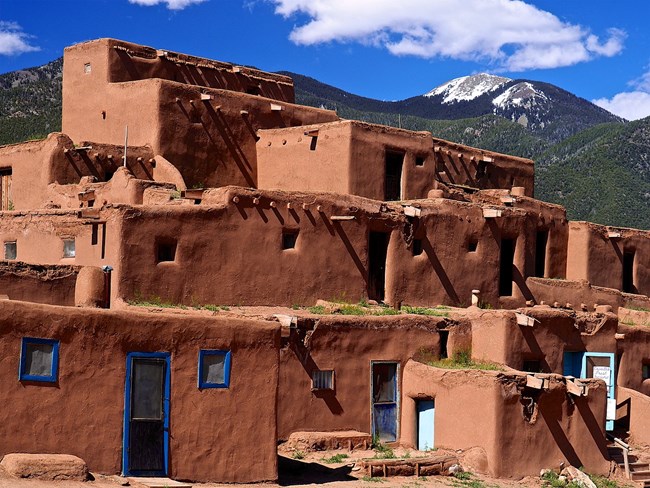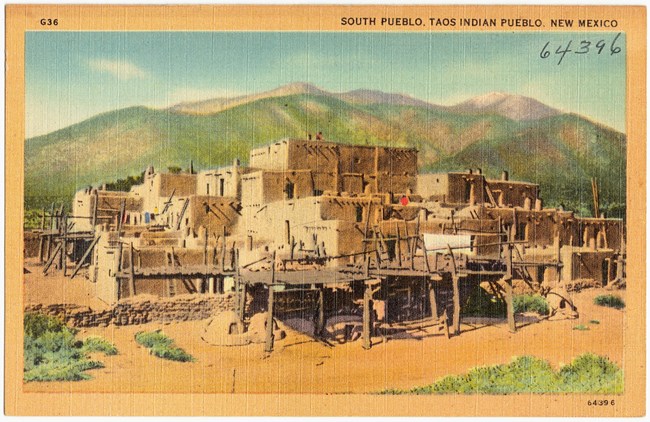Last updated: July 23, 2020
Article
Taos Pueblo: World Heritage Site

By John Mackenzie Burke - Own work, CC BY-SA 4.0, https://commons.wikimedia.org/w/index.php?curid=78067130
Taos Pueblo is a remarkable example of a traditional type of architecture from the pre-Hispanic period of the Americas. It is unique to this region and has successfully retained most of its traditional forms to the present day. Thanks to the determination of the Native American community -- members who have called this place home for the past 1000 years -- Taos Pueblo and its living culture have been successfully preserved.
Taos Pueblo displays the traditional method of adobe construction. The Pueblo proper consists of two clusters of houses, each built from sun-dried mud brick, with walls ranging from 70 centimeters (28 inches) thick at the bottom to approximately 35 centimeters (14 inches) at the top. Each year, the walls are still refinished with a new coat of adobe plaster as part of a village ceremony.
Taos is the best preserved of the pueblos north of the borders defined by the Treaty of Guadalupe Hidalgo (1848). A sovereign tribal government governs the Pueblo. It is the only World Heritage Site in the United States cited for the significance of its traditional Native American living culture.
Situated in the valley of a small tributary of the Rio Grande, Taos Pueblo exemplifies the enduring culture of its Native American inhabitants. A powerful reflection of the cultural interactions between American Indians and the Spanish, the pueblo provides remarkable insights into the heritage of the American Southwest. One of a group of settlements established in the late 13th and early 14th centuries in the valleys of the Rio Grande, Taos has survived for hundreds of years with its cultural integrity intact while simultaneously borrowing from Spanish and Anglo-American cultures over centuries of contact.

The original pueblo site is directly east of where the adobes stand today. Likely constructed around 1325 AD, the first Taos Pueblo is now a ruin and sacred site referred to as “Cornfield Taos.” The limited archeological excavation at Cornfield Taos provided evidence that the Pueblo relocated slightly to the west to its current location, around 1400 AD.
Throughout its early years, Taos Pueblo was a central point of trade between the native populations along the Rio Grande and their neighbors to the northwest, the Plains Tribes. Taos Pueblo hosted a trade fair each fall after the agricultural harvest. This fair impressed the first Spaniards who made contact with the ancient pueblo. Eventually trade routes would link Taos to the northernmost towns of New Spain and the cities of Mexico via the famed Chihuahua Trail.
The first Spanish visitors to Taos Pueblo arrived in 1540 as members of the Francisco Vásquez de Coronado expedition, which stopped at many of New Mexico’s pueblos in search of the rumored Seven Cities of Gold. At the time, Hernando de Alvarado described the pueblo as having adobe houses built very close together and stacked five or six stories high. Throughout recorded history, descriptions of Taos Pueblo stress the adobes’ stacked and stepped-back form.
The buildings at Taos originally had few windows and no standard doorways. Instead, access to rooms was through square holes in the roof that the people reached by climbing long, wooden ladders. Cedar logs (or vigas) supported roofs that had layers of branches, grass, mud, and plaster covering them. The architecture and the building materials were well suited for the rigors of the environment and the needs of the people in the Taos Valley.
Visitors to Taos can explore the Pueblo’s other notable features, including its surrounding defensive wall, the sacred ruins of Cornfield Taos, large unexcavated ancient trash middens, and a ceremonial racetrack. Rubble mounds and a lone bell tower mark the ruins of the original Spanish church, San Geronimo de Taos.
Taos Pueblo UNESCO page: https://whc.unesco.org/en/list/492/
Taos Pueblo City page: https://taospueblo.com/
